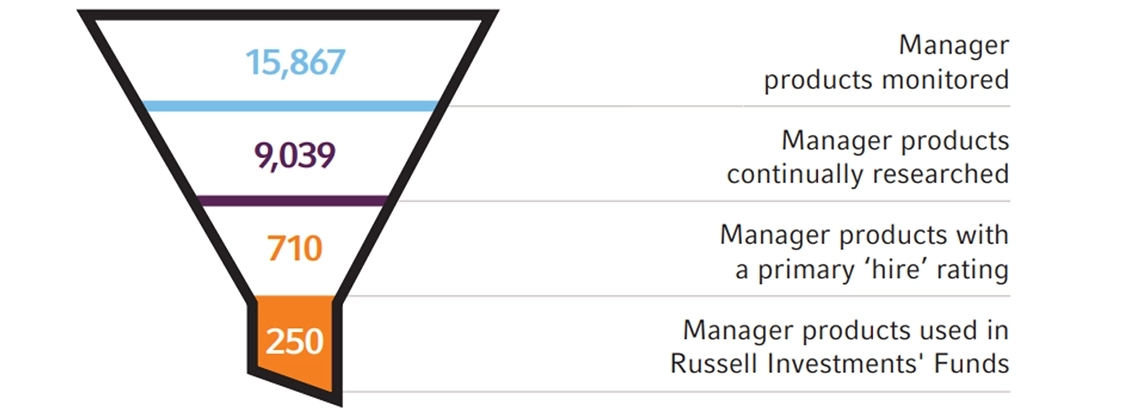by Kevin Nielsen, Russell Investments
Executive summary:
- The team executives who choose players in the National Football League draft have a job similar to that of an advisor picking funds for an investment portfolio.
- Both have a broad universe from which to select and conduct extensive research before making their picks.
- For an advisor, this process can take time and resources better used to serve clients.
- A model provider can conduct the analysis, providing expertise and insight and allowing advisors to focus on helping clients build their wealth.
The 2024 National Football League draft has kicked off in Detroit, and I'm watching it closely. There are 15,167 NCAA D1-FBS scholarship athletes. Of those, only 259 will get drafted. This means that among all Division 1 FBS college football players, only 1.7% are good enough to make the cut.
The amount of research a team does on those players is extraordinary. Their size, statistics, games played, training history, and other details all play a critical part in measuring their success. Additionally, qualitative assessments are conducted through interviews and Wonderlic tests. Their personal life and off-field activities also play into the evaluation.
The investment landscape today is just as daunting. More than 15,000 money managers are available to work with when building portfolios. Finding the right one can take time and resources away from you that you could ultimately give back to your clients or family. By partnering with a trusted model provider, advisors can access a wealth of expertise and insight. This allows them to focus on serving clients and prospecting new ones while being more effective wealth managers, ultimately enhancing their overall practice.
A multi-manager approach
With that big of a manager universe to consider, it's clear that not all the top performers reside under the same roof. Each institution may excel in a different sector, asset class, or geography. The key lies in sifting through this vast array and pinpointing not just the best. Still, the most suitable manager to fulfill an overall portfolio and complement the other managers selected.
Much like the NFL draft, portfolio managers undergo rigorous evaluations. Their track record, investment process, and stock selection process are considered. Additionally, qualitative assessments, including manager interviews and onsite visits, offer insights into their character and decision-making prowess.
For example, Russell Investments keeps track of over 15,000 managers and continually researches more than 9,000 manager products. Of all these managers, only around 700 receive a hire rating from us. However, we select only 250 of them to be used in our funds. The odds of being selected are similar to those of college athletes in the NFL draft!
INVESTMENT APPROACH

As of December 31, 2023.
Capacity
While finding the perfect manager is crucial, understanding their limitations is equally important. Small-cap funds, for example, can be susceptible to capacity constraints. As their assets under management (AUM) grow rapidly, their ability to effectively execute trades can be hampered. To maintain performance for existing investors, they may resort to "soft closures," essentially shutting out new investors.
This can present a challenge for advisors who may have taken time and effort to identify a high-performing manager only to have them close the fund to new investors. This scenario is surprisingly common in certain asset classes like small cap. At the time of writing this, nearly one out of 10 small cap funds were soft-closed to new investors.1 This leaves you in a bind: start your research all over again or manage a portfolio with a mix of open and closed funds.
However, the effectiveness of this approach is debatable. Studies suggest that closed funds often include performance-sensitive investors likelier to redeem their shares when performance dips.2 This can negate the intended benefit of a soft closure.
The multi-manager approach offers a solution. By centralizing trading across multiple managers, this strategy eliminates capacity constraints. If one manager recommends buying Tesla while another might suggest selling, a multi-manager approach can offset those trades. This helps reduce risk, and for non-qualified accounts, it can enhance tax efficiency by minimizing excess trading and potentially eliminating unnecessary taxable transactions.
Access
The institutional investment landscape, encompassing more than $70 trillion in assets, presents a complex and lucrative opportunity. From defined benefit plans to sovereign wealth funds, this market demands sophisticated investment strategies and a unique approach to portfolio construction. However, access to this level of research and expertise is often out of reach for most retail investors due to high minimum investment requirements or product limitations.
A multi-manager approach unlocks this exclusive world. By strategically selecting specialist portfolio managers, this approach leverages their insights for the benefit of the average investor. The multi-manager approach democratizes institutional investing, making sophisticated strategies and top-tier research available to a broader range of investors.
The bottom line
Picking the right portfolio manager is like picking the next franchise player for an NFL team. Leveraging an asset manager with deep roots in manager research can take the pressure off you and put time back into your day.
1 Source: Russell Investments. Morningstar
2 Source: https://journals.plos.org/plosone/article?id=10.1371/journal.pone.0290254#sec019
Copyright © Russell Investments















